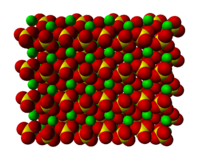Strontium sulfate facts for kids
Quick facts for kids Strontium sulfate |
|
|---|---|
 |
|
| IUPAC name | Strontium sulfate |
| Other names | Celestine |
| Identifiers | |
| CAS number | |
| PubChem | |
| EC number | 231-850-2 |
| SMILES | [Sr+2].[O-]S([O-])(=O)=O |
|
InChI
InChI=1/H2O4S.Sr/c1-5(2,3)4;/h(H2,1,2,3,4);/q;+2/p-2
|
|
| Properties | |
| Molecular formula | |
| Molar mass | 0 g mol-1 |
| Appearance | white orthorhombic crystals |
| Density | 3.96 g/cm3 |
| Melting point | |
| 0.0135 g/100 mL (25 °C) 0.014 g/100 mL (30 °C) |
|
|
Solubility product (Ksp)
|
3.44 x 10−7 |
| Solubility | insoluble in ethanol, alkalis slightly soluble in acids |
| −57.9·10−6 cm3/mol | |
| Refractive index (nD) | 1.622 |
| Structure | |
| Crystal structure | Orthorhombic, oP24 |
| Space group | Pnma, No. 62 |
| Thermochemistry | |
| Std enthalpy of formation ΔfH |
−1453.1 kJ·mol−1 |
| Standard molar entropy S |
117.0 J·mol−1·K−1 |
| Hazards | |
| NFPA 704 |
|
| Flash point | Not flammable |
| Related compounds | |
| Other anions | Strontium chloride Strontium oxide |
| Other cations | Beryllium sulfate Magnesium sulfate Calcium sulfate Barium sulfate |
| Except where noted otherwise, data are given for materials in their standard state (at 25 °C, 100 kPa) | |
Strontium sulfate (with the chemical formula SrSO4) is a chemical compound made from the elements strontium, sulfur, and oxygen. It is a type of salt, similar to the table salt you use on your food, but with different ingredients.
In nature, strontium sulfate is found as a mineral called celestine, which can form beautiful, often pale blue, crystals. As a powder, it is white and does not dissolve well in water. Imagine trying to stir sand into a glass of water—strontium sulfate behaves in a similar way.
Contents
What is Strontium Sulfate's Structure?
Strontium sulfate is made of many atoms linked together in a repeating pattern, forming a crystal. This structure is very similar to another compound called barium sulfate.
One of the most interesting facts about strontium sulfate is that a special group of tiny ocean creatures, called Acantharea, use it to build their amazing and complex skeletons. These single-celled organisms are a type of protozoa and rely on this compound to create their beautiful, spiky structures.
What is Strontium Sulfate Used For?
While you might not find strontium sulfate in many everyday products, it is very important in industry as a starting material for creating other useful strontium compounds.
Making Red Fireworks
The most exciting use for strontium compounds is in pyrotechnics, which is the science of making things like fireworks and flares. When compounds made from strontium are heated, they burn with a brilliant, bright red color. Strontium sulfate is often the first step in making the chemicals that give fireworks their amazing red glow.
Starting Point for Other Materials
In factories, strontium sulfate is often changed into other chemicals that have more uses.
- Strontium carbonate: This is used to make special kinds of ceramics and was once very important for making the glass in old-style television screens.
- Strontium nitrate: This is another compound that is used to create the red color in fireworks and road flares.
A Problem in Pipes
Because strontium sulfate doesn't dissolve well in water, it can sometimes cause problems. In places like underground oil wells, water flowing through the ground can pick up strontium and sulfate. When these two meet inside pipes, they can form a hard, crusty layer called "scale." This scale can build up and clog the pipes, similar to how hard water stains can build up on a faucet at home.


